The Brazilian Carnival (Carnaval) is an annual festival in Brazil held 40 days before Easter and marks the beginning of Lent. During Lent, Roman Catholics are supposed to abstain from all bodily pleasures, including the consumption of meat.
The modern Brazilian Carnival finds its roots in Rio de Janeiro in the 1845s, when the city’s bourgeoisie imported the practice of holding balls and masquerade parties from Paris. It originally mimicked the European form of the festival, over time acquiring elements derived from African and Amerindian cultures.
In the late 19th century, the cordões (literally laces or strings in Portuguese) were introduced in Rio de Janeiro. These were groups of people who would parade through the streets playing music and dancing. Today they are known as blocos (blocks), consisting of a group of people who dress in costumes or specials t-shirts according to certain themes or to celebrate the Carnival. Blocos are generally associated with particular neighbourhoods or suburbs and include both a percussion or music group and an entourage of revellers.
This "blocos" have become a big part of Rio de Janeiro's Carnival. There are more than 100 "blocos" nowadays and each year this number increases. Some are big, some are small, most concentrate in square and later parade though the streets and a few stay in the same place all the time. Each "bloco" has its place or street to parade and the big ones usually close the streets for car traffic. They usually start in January and last till the end of Carnival, so since the beginning of the year you can see a group of people dancing samba in any street of Rio in the weekends and during Carnival every day.
"Blocos" parade in Copacabana, Ipanema, Leblon, Lagoa, Jardim Botanico, Downtown etc. They usually take place during the day till night but a few starts after work time and you can see people going straight from work. Usually the people who organized the "bloco" compose their own music which plays all the time during the parade with old carnival musics called "Marchinhas de carnaval" and sambas that have become classics. The most important "blocos" are: "O cordão do bola preta" that parade in downtown streets, in the heart of Rio's historical center. "Suvaco de Cristo" (Christ's armpit in Portuguese), because it parades in a street call Jardim Bortanico, near Rio de Janeiro's Botanic Garden and below the Christ the Redeemer statue. Monobloco is another bloco that has become so famous that their band plays all year round in parties and small concerts.
Carnival in Rio de Janeiro is known worldwide for its elaborate parades staged by the city’s major samba schools in the Sambadrome and is one of Rio’s major tourist attractions. Each samba school rehearses all year round for this event and all of its members take part in the rehearsals, whether experts or not. It is a place where people who always wanted to write a song, play a percussion instrument or choreograph a dance will have their opportunity. It is usual that during the carnival aristocrats dress up as commoners, men cross-dress as women, and poor people dress up as princes and princesses - social roles and class differences are expected to be forgotten once a year, but only for the duration of the festival.
Samba schools are very large, well-financed organizations that work year round in preparation for Carnival. Parading in the Sambadrome runs over four entire nights and is part of an official competition, divided into seven divisions, in which a single samba school will be declared that year’s winner. Blocos deriving from the samba schools also hold street parties in their respective suburbs, through which they parade along with their followers.
The huge Samba Schools of Rio de Janeiro sometimes choose political or social commentary and criticism, as for instance the “Mama, I Want Manaus” enredo (“theme”) of the 1984 Carnival which satirized the greed of Brazilians who go to the Amazonian city of Manaus to by duty-free goods such as imported electronics and designer clothing.![]() More on Brazil:
More on Brazil:![]() Brazilian Ecotourism - Fauna Watching
Brazilian Ecotourism - Fauna Watching![]() Recife - Pernambuco
Recife - Pernambuco![]() Salvador - Bahia
Salvador - Bahia![]() Sao Paulo
Sao Paulo![]() Brazilian Ecotourism - Ornithology
Brazilian Ecotourism - Ornithology![]() Tom Jobim - Brazilian Music
Tom Jobim - Brazilian Music![]() World Heritage Cities
World Heritage Cities
December 30, 2007
Brazilian Carnival - Rio de Janeiro
0
comments
0
comments
|
|

 Welcome to Travel to Brazil.
Welcome to Travel to Brazil.
